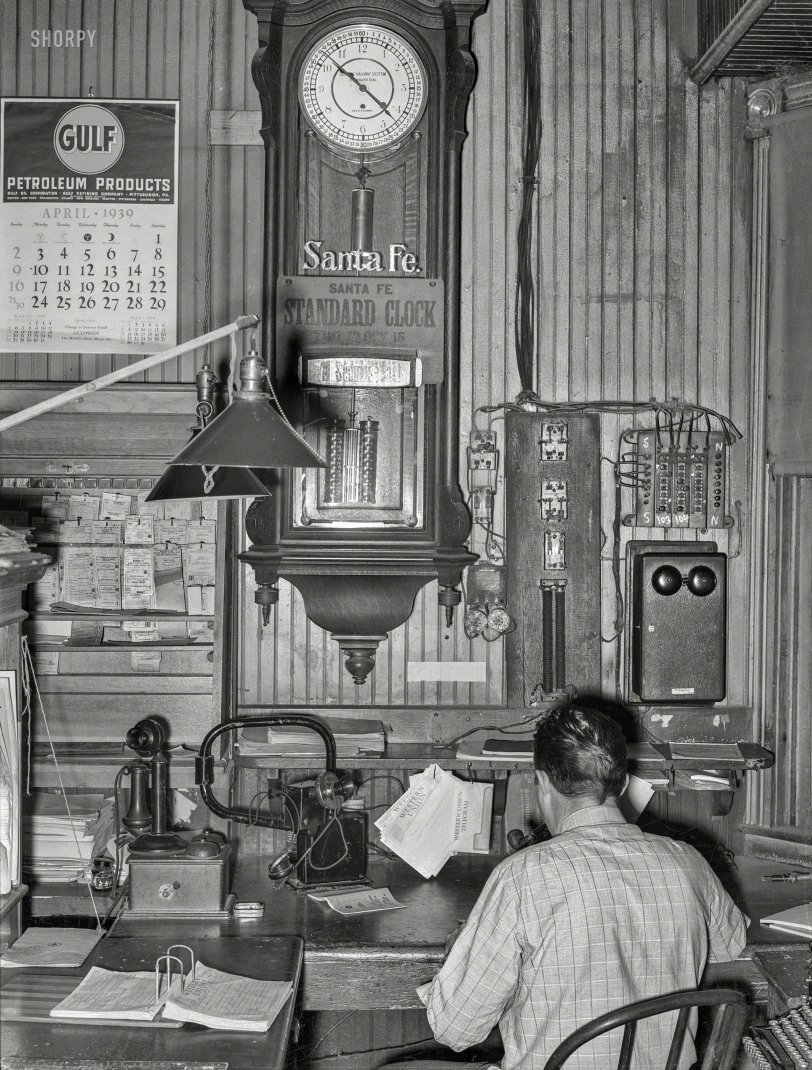


Framed or unframed, desk size to sofa size, printed by us in Arizona and Alabama since 2007. Explore now.
Shorpy is funded by you. Patreon contributors get an ad-free experience.
Learn more.

- Baldwin 62303
- Baldwin VO-1000
- Cold
- No expense spared
- Tough Guys
- Lost in Toyland
- And without gloves
- If I were a blindfolded time traveler
- Smoke Consumer Also Cooks
- Oh that stove!
- Possibly still there?
- What?!?
- $100 Reward
- Freeze Frame
- Texas Flyer wanted
- Just a Year Too Soon
- WWII -- Replacing men with women at the railroad crossing.
- Yes, Icing
- You kids drive me nuts!
- NOT An Easy Job
- I wonder
- Just add window boxes
- Icing Platform?
- Indiana Harbor Belt abides
- Freezing haze
- Corrections (for those who care)
- C&NW at Nelson
- Fallen Flags
- A dangerous job made worse
- Water Stop
Print Emporium
Santa Fe Time: 1939

April 1939. "Office of train dispatcher and Western Union. San Augustine, Texas." Photo by Russell Lee for the Farm Security Administration. View full size.
Re: Number Please
The "large metal box" on which the candlestick phone rested was, in this photo, wood; you can see the dovetail joints on the curved corners.
The box itself was called a "subset" and housed the meager electronics to make the phone operate, as well as the bell on top. The crank wound a dynamo, also inside the subset, to generate electricity to make a call.
1909 Seth Thomas Clock
And if you have a spare $112,000 lying around you can own one too!
Covetous!
I would dearly love that beautiful Seth Thomas clock!
10:22:52 and a fraction; can't tell if it's 3 or 5 beats to the second, but it's certainly finely divided. And with a precision, temperature compensated pendulum.
Phone Terminal
Upper right corner of the photo shows a telephone connection strip. It appears the lines going N have been cut. Was this the most northern station?
Tighten cap. Tip bottle to fill the well
And on the left, a bottle of Sheaffer Skrip ink, with the little side reservoir just inside the lip of the bottle. Convenient for filling your fountain pen without picking up the crud from the bottom! But it looks as if our railroad man didn't follow the first line of the instructions.
Operator, I'd say
This busy guy is doing the work for an entire station, I believe. He's probably in and out handing up train orders, doing telegrams for the public and the railroad, taking phone calls from up and down the line, and, if you look to the left side of the photo under the calendar, he's also the ticket seller. That's what the rack is full of. Likely a broom just out of sight for his slow periods. And, he probably has to maintain and wind that beautiful clock with the interesting face. What a fella!
Train Order Operator / Telegrapher
This man appears not to be a dispatcher (a person in charge of train movements on a subdivision) but rather an operator / telegrapher who relays instructions from the dispatcher to the train using typed or handwritten messages (see the bottle of Sheaffer Skrip ink to the left of the telephone). You will note that there is no train sheet on the desk in front of him to record train movements, and a dispatcher would probably not have time to be distracted by the sending or receiving of Western Union messages.
Train orders ready to be delivered to upcoming trains would be hung on the hooks above the desk -- perhaps we can see the corner of one over his right shoulder. To see a Santa Fe dispatcher in Amarillo from the same era see this Shorpy photo.
Dispatchers and Telegraphers
Dispatchers and telegraphers usually used special typewriters. Railroad rules usually specified train orders be hand written or typed in multiple copies on a thin semitransparent paper called flimsy. If typed they must be in all caps with no punctuation, so there is no shift key. All letters were caps. I suspect this particular typewriter had the extra row of keys for typing characters that would normally be accessed with the shift key. Railroads normally didn't use all characters, but this feature may have been useful for Western Union telegrams. This also explains Western Union's use of the word "STOP" instead of ".", as most railroad typewriters had no "."
Another railroad oddity is that there is no ribbon. Multiple copies were typed "in manifold" using double-sided carbon paper. The image on the first and all odd numbered pages was actually imprinted in reverse by carbon on the back of the paper, and read through the paper, while even numbered pages were impressed with their images on the front.
Exra row of keys
I suspect this is not an ordinary typewriter, but a form of teletype machine. The extra keys may have been to transmit various codes or information, other than printable characters.
Extra keys under the typewriter?
Can anybody figure out what's going on with the extra row of keys (?) under the spacebar?
Number Please
When we were kids back in the early 60s we had a candlestick phone just like the one shown here (no dial). Unfortunately we played with it as kids do and ultimately messed it up so bad, taking it apart etc., that Mom ended up tossing it. Similar to the one here, it came with a large metal box in which all of the telephone circuitry and bell were housed. Later on I guess Western Electric figured out how to cram all that stuff into the phone itself.
























On Shorpy:
Today’s Top 5